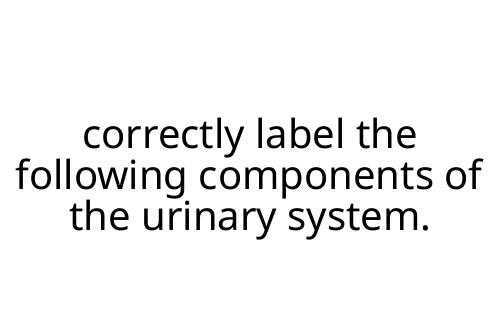correctly label the following components of the urinary system
If you’re studying anatomy or prepping for a quiz, being able to correctly label the following components of the urinary system is essential. The urinary system handles waste removal and regulates water and electrolyte balance in your body. Let’s break down the main structures you need to know, their functions, and some tips to help you remember them.
Key Components of the Urinary System
Here’s what you’ll need to label and understand:
-
Kidneys
These are two bean-shaped organs in your lower back. The kidneys filter your blood, removing waste and extra fluids to create urine. Their cortex and medulla each have essential roles in filtration and urine production. If you’re facing a labeling diagram, look for the largest, uppermost structures on each side of the spine. -
Ureters
Ureters are narrow, muscular tubes. They connect each kidney to the bladder, carrying urine by peristaltic movement (a wave-like muscle contraction). On diagrams, they run vertically and are usually shown descending from the center of each kidney to the bladder. -
Urinary Bladder
This organ is a muscular sac that collects and stores urine. Located in the pelvis, it sits behind the pubic bone. When full, it feels round and firm. On most diagrams, the bladder appears as a large, balloon-like structure at the base of the system. -
Urethra
The urethra is a narrow tube that carries urine from the bladder outside the body during urination. Its length and path vary by sex, but on diagrams, it’s always the last exit of the system, starting at the bladder and ending at the body’s exterior.
Supporting Structures Worth Knowing
While these four are the main stops, you may also need to spot and label:
- Renal arteries and veins: Supply and drain blood to and from the kidneys.
- Renal pelvis: The funnel-shaped reservoir in each kidney where urine collects before entering the ureter.
Tips for Correct Labeling
-
Follow Flow Direction
Always think about the path urine takes: kidneys → ureters → bladder → urethra. This will guide your labeling in sequence and help avoid mix-ups. -
Look for Landmarks
Identify the spine, pelvic area, and symmetry — kidneys are paired and near the midline, while the bladder sits centrally at the bottom. -
Identify Relative Size and Shape
Kidneys are bean-shaped; ureters are thin lines; the bladder is round and expandable; the urethra is the final straight path out.
Pros and Cons of Labeling Diagrams
Pros:
- Boosts memorization and understanding.
- Prepares you for class, exams, or healthcare work.
- Visualizing connections clarifies functions.
Cons:
- Can be tricky if diagrams aren’t clear or if you memorize location instead of purpose.
- Over-reliance on diagrams sometimes leads to forgetting exact terms.
Final Thoughts
To correctly label the following components of the urinary system, focus on practicing with diagrams and understanding each part’s function and position. Use mnemonics, repetition, and double-check your work. Solid grasp of these basics lays the groundwork for deeper learning in biology, nursing, or health sciences.


 Senior Hair Health Advisor
Maria is a dedicated professional specializing in hair health and wellness. She brings a wealth of knowledge on how to maintain strong, resilient hair through natural and science-backed methods. Maria’s detailed guides and expert advice help readers enhance their hair health, offering personalized solutions to common hair concerns.
Senior Hair Health Advisor
Maria is a dedicated professional specializing in hair health and wellness. She brings a wealth of knowledge on how to maintain strong, resilient hair through natural and science-backed methods. Maria’s detailed guides and expert advice help readers enhance their hair health, offering personalized solutions to common hair concerns.
